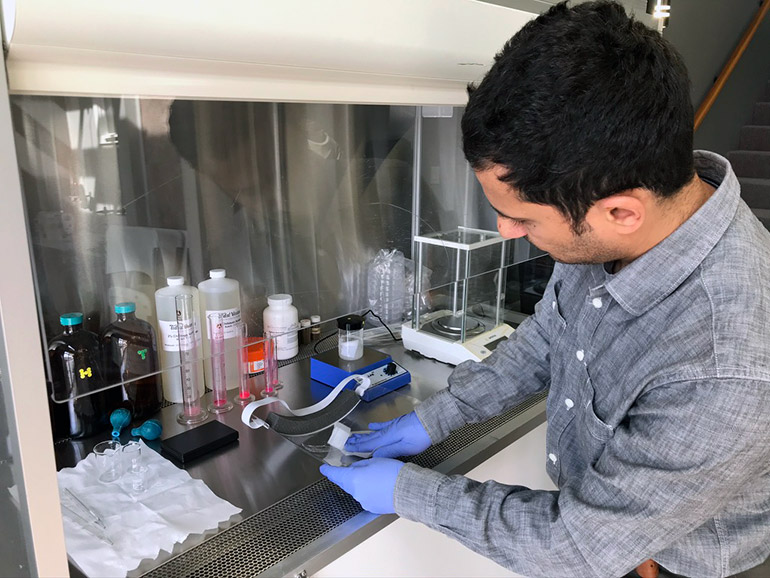
Chief Scientist at PRE Labs Mazeyar Parvinzadeh Gashti tests several different soap products on a protective face shield.
Fogged-up protective face shields proving problematic
A tweet for help, a response from a researcher and a collaboration with a safety products manufacturing company have frontline healthcare workers seeing clearly through their protective face shields.
A few weeks ago, UBC School of Nursing Professor Sally Thorne tweeted that nurses, health care professionals and frontline workers were looking for an anti-fogging solution for glasses, goggles and visors for people who need to wear a tight-fitting mask.
UBC Okanagan researcher Kevin Golovin replied to Thorne, suggesting that his team at the Okanagan Polymer Engineering Research and Applications Lab might be able to help. Golovin conducts research on specific material coatings, investigating ice-repellent surfaces and water-resistant textiles. He reached out to colleagues at Kelowna-based PRE Labs—a company that manufactures protective products including face shields. This started the ball rolling, with a number of people offering to help.
For many frontline workers, especially those who wear corrective lenses, dealing with fogged-up glasses or face shields was part of the daily routine, explains Sybil Hoiss, a clinical nurse specialist with Interior Health.
“Personal protective equipment (PPE) fogging up has been a nuisance for staff for many years,” says Hoiss. “Even before COVID-19.”
But for anyone working on the frontlines during COVID-19, the shifts were long and people were wearing their PPE for extended hours.
Golovin says there are a number of DIY solutions to fogging, including rubbing soap or toothpaste on the inside of goggles, facemasks or steamy bathroom mirrors. For a test, he reached for a substance the hospital had on hand. Soap.
“We did a quick test by dipping plastics into a soap bath made with ordinary dishwashing soap and it worked well,” says Golovin. “There are no negative side effects on the plastic and the surface remains clear as long as there is no agitation.”
While the idea of dipping a protective shield in a mixture of dishwashing soap and water looked positive, Hoiss notes that was not a practical solution in a clinical setting. The next idea was to create a soap mixture that could be sprayed directly onto a clean shield. They also needed to create a system that would provide fog-free visions for a minimum of three to four hours.
Mazeyar Parvinzadeh Gashti, chief scientist at PRE Labs, got to work experimenting with some ideas.
“We did a couple of tests to evaluate the performance of a diluted soap,” he explains. “We added 2 ml dishwashing soap into 100 ml regular tap water and then sprayed the inner side of the face shield which was left at room temperature for 15-20 minutes to be completely dried. The face shield became anti-fogging.”
Other tests included wiping the inside, instead of letting it air dry. Using a paper towel left marks, but when the inside was rubbed with a microfibre tissue, it seemed to work perfectly. The researchers tested the pH of each soap—if they were acidic they wouldn’t work.
Parvinzadeh says they tested three different types of soap, including commercial-grade, and several cleaning products supplied by Interior Health including a disposable soap towelette.
The towelette worked, and since it was already on supply the idea has since been implemented. The process is easy and convenient for frontline staff. And, says PRE Lab CEO Brad Field, it works.
“It is a simple, yet elegant solution,” says Field. “Identified through industry and academia collaboration in very short order, this solution improves the ability of frontline professionals to more effectively utilize their PPE and at no cost to Interior Health.”
Golovin is pleased how social media catalyzed the whole project: a tweet led to a conversation that led to a small collaborative side project, and a solution was ready in a matter of days.
“Right now, it isn’t about research that helps people in five years or even five months,” says Golovin. “It’s about coming together today with solutions that can save lives tomorrow. That means academia, local business and healthcare professionals working cooperatively to solve the most pressing problems.”
Hoiss says the collaboration is also a step towards making the workday a bit easier for the healthcare and frontline workers.
“This is excellent news because we can use a product we already have in hospital,” says Hoiss. “On behalf of everyone who has suffered with fogged-up shields, I want to say thank you for the work done looking for a solution. This shows how teamwork and collaboration across disciplines can yield solutions we thought were elusive.”